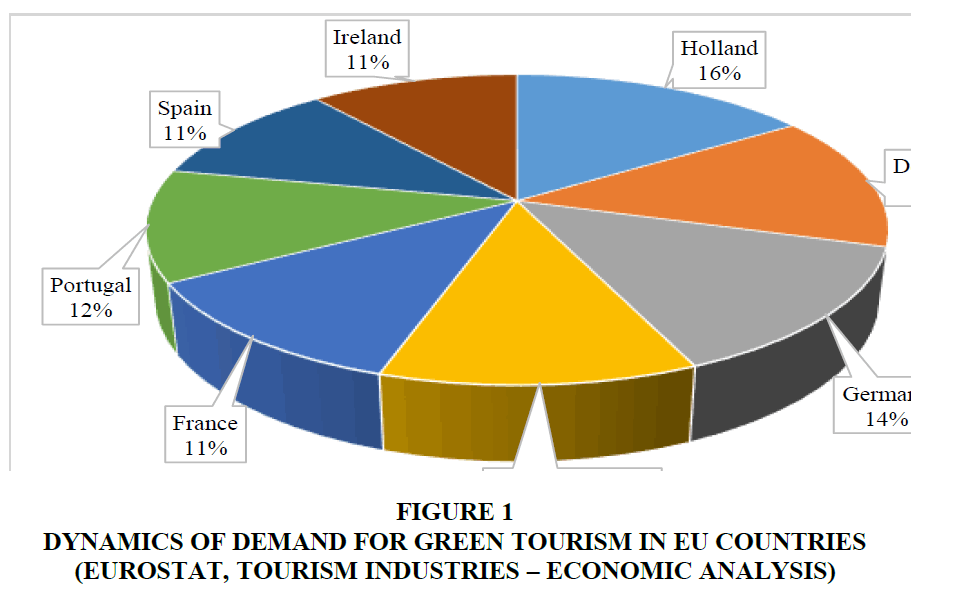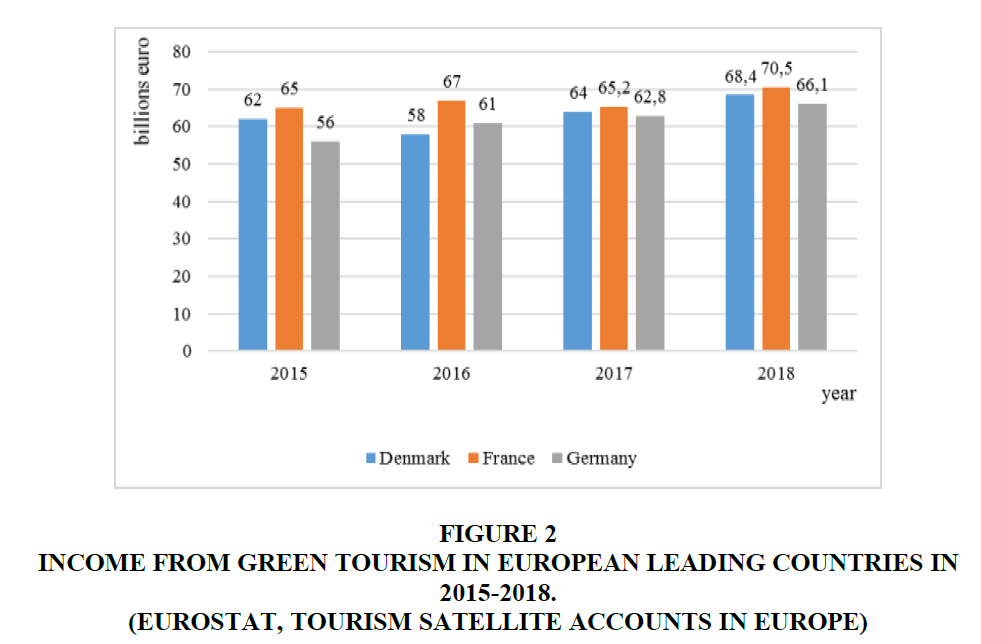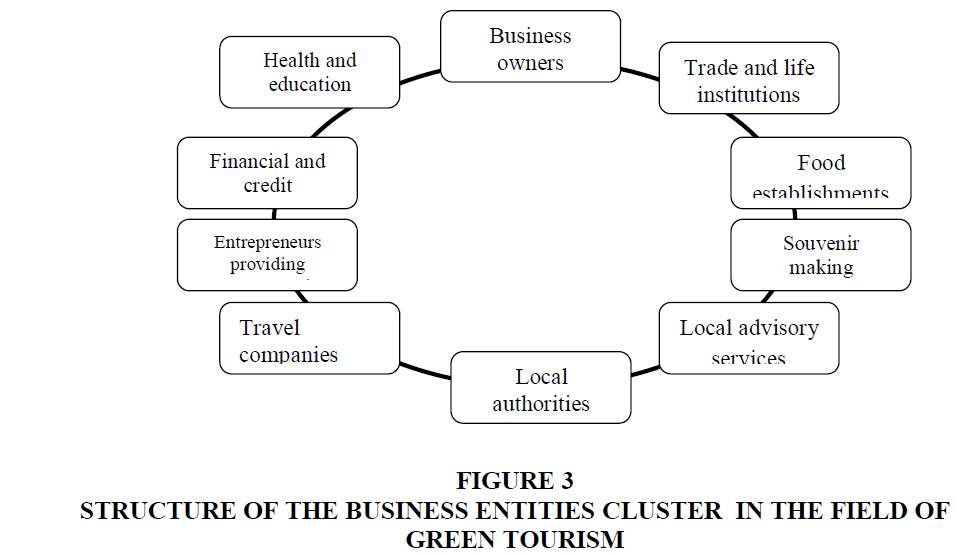Research Article: 2020 Vol: 26 Issue: 4
Establishment of Entrepreneurial Activities in the Field of Green Tourism in European Countries
Tatyana Petruk, Lviv Institute of Economics and Tourism
Heorhii Skliar, Higher Educational Establishment of Ukoopsilka Poltava University of Economics and Trade
Anzhela Shukanova, Poltava V.G. Korolenko National Pedagogical University
Victor Yemtsev, National University of Food Technologies
Vasyl Shykerynets, Vasyl Stefanyk Precarpathian National University
Abstract
The article considers the current issue of active and necessary development of entrepreneurship in the field of green tourism in European countries. A statistical analysis of the demand for green tourism in the EU countries and the dynamics of generating profits from green tourism were conducted. Practical tools for engaging rural people in green entrepreneurship activities are substantiated. A new structure for a cluster of entrepreneurial entities in rural green tourism has been proposed.
Keywords
Entrepreneurship, Green Tourism, Tourism Industry, Tourism Product, Cluster Of Business Entities, National Interests.
Introduction
Today the tourism industry of the world is undergoing active development and formation of new directions of entrepreneurial activity. Along with traditional types of tourism, all kinds of unconventional forms of recreation and traveling are becoming widespread. The spread of greening ideas has an increasing impact on tourism. In most European countries, rural tourism is encouraged at the state level at the private-business level. Green tourism has convincingly proved that it is an important factor in solving the socioeconomic problems of the village - it is employment growth, development of rural infrastructure, obtaining stable and significant income, strengthening the budget of rural settlements. However, while paying attention to the issue of green tourism development, there is a need for a deeper study of this problem and for defining the organizational foundations for the development of this type of entrepreneurship.
Literature Review
Organizational and economic factors of tourism development in the world are presented in scientific works (Bhatia, 2006; Cooper et al. 2008; Holloway, 2009). Such researchers pay attention on the question of establishment of green tourism in their scientific works (Beaumont, 2011; Gössling, 1999; Rutty et al., 2014). Such researchers refer to determining the benefits of green tourism and analyzing the current state and prospects for its development (Crouch et al., 2005; Font et al., 2017). In the present conditions of uncertainty of understanding further development of green tourism, constant changes in the regulation sphere, there is a need for further studying the theoretical foundations of its development in the field of the tourism industry as a whole.
Methodology
The methodology of the study is formed by the following statements: (1) the theory of change, according to which, over the last decade, tourism has changed significantly and will continue to change and develop in the future; (2) Processivity and tendency. Studies of the world tourism business show that the following trends will become more important in its development: tourism focuses more on specific interests such as flexibility and individuality, which will become key service technologies; the intensity of travel in the next few years will increase; (3) time-lag theory indicates that tourists will increasingly use vacation more than once a year; the number of older tourists, as well as younger people, will increase steadily; more environmentally and culture-oriented activities will be required; with the development of tourism without borders, the need for transport and worldwide information networks will increase significantly.
Findings and Discussion
Tourism in the XXI century. is a social and political phenomenon, it has a significant impact on the world order and economy of many countries and entire regions. World tourism has been particularly successful over the last 30 years, when international tourism has grown on 3.8 times and its foreign exchange earnings increased 25 times.. Along with the development of such popular types of tourism as extreme tourism, caving, etc., green tourism has become an alternative direction .
Typically, rural areas have a low population density as a result of small settlements. The Green Co-operation Program of the “Organization for Economic Co-operation and Development” uses several sets of indicators, but favors a criterion such as a population density of 150 people per km2. The average density of rural population differs between countries due to the existence of various classifications in different countries (shows in Table 1).
| Table 1 Criteria for Determining Rural Settlements in the Countries of the “Organization for Economic Cooperation and Development of Green Tourism” |
||
| № | Country | Selection criteria |
| 1 | Australia | Dispersed population groups below 1,000 people |
| 2 | Austria | Settlements with a population of up to 5,000 people |
| 3 | Denmark, Norway | Settlements of up to 200 people |
| 4 | France | Settlements with a population of up to 2,000 people |
| 5 | United Kingdom | Areas with a rural economy and a population of up to 10,000 people |
| 6 | Switzerland, Portugal | Settlements with a population of up to 10,000 people |
Thus, from the Table 1, it can be concluded that the largest number of agricultural and population territories is observed in countries such as: the United Kingdom, Portugal, and Switzerland. The smallest criterion of rural settlements is observed in Denmark and Norway. Besides this, rural settlements may vary in size, but they are small (with a population of less than 10,000 people) and are mostly located in areas with low population density. It is quite difficult to define such notion as a modern "rural lifestyle", especially with regard to postindustrial countries in Europe, such as Germany, France, Belgium, etc. Too large differences are observed not only between continents (North - South, West - East), individual groups of countries, but even within individual countries (European tourism 2018-Trends & Prospects).
For a long time, France was the leader in supply and demand for rural tourism, where in 1951 an organization was created to offer shelter in villages during the holidays. A few years later, the National Federation for the Development of Rural Tourism was founded. Gradually, such organizations were registered in other Western European countries. Today, in the countries of Western and Central Europe, the rural environment plays an important role in the usage of leisure time and in tourism shows in Figure 1.
Figure 1 Dynamics of Demand for Green Tourism in Eu Countries (Eurostat, Tourism Industries – Economic Analysis)
So, Figure 1 shows that almost 1/5 of all tourist trips to the European Union are made in rural areas: in Holland it is 16%, in Denmark - 14%; in Germany - 14%; in the UK, France and Portugal - 34%; in Spain and Ireland - 22%. Interest to rural recreation in these countries has been increasing for several decades (Eurostat, Tourism industries – economic analysis).
Figure 2 depicts the profit dynamics of the three leading European countries over the last three years.
Figure 2 Income from Green Tourism in European Leading Countries in 2015-2018. (Eurostat, Tourism Satellite Accounts in Europe)
Thus, from Figure 2 it can be seen that in 2015, France received the highest profit from green tourism - 65 billion euros, followed by Denmark - 62 billion euros, while the lowest profit from green tourism was observed in Germany - 56 billion euros. Another trend is observed in 2016: a significant decrease in profits from green tourism in Denmark - by 4 billion euros, but in France and Germany, the income from green tourism revenues has increased. In 2017. France's leading position has declined, with profit falling to 65.2 billion euros , but in 2018, theincome from green tourism has increased to 64.5 billion euros, in Germany to 62.8 billion euros. In 2018, green tourism revenue increased significantly in all three European countries, amounting to 70.5 billion euros in France, 68.4 billion euros in Denmark, and 66.1 billion euros in Germany. (Eurostat, Tourism Satellite Accounts in Europe).
Nowadays, all national green tourism organizations in Europe have gathered into the The European Federation of Rural Tourism – EuroGites. The main goals of this organization are to promote the development of green tourism and the targeted investment of rural tourism development projects. Each of the European countries has its own characteristics of the organization of green tourism. In Italy, green tourism is more linked to spa, tasting and gastronomic tourism. In Austria, green tourism includes grass gathering, dairy preparation, active hiking and eco-recreation. In Finland, green tourism refers to a vacation on the banks of protected lakes and rivers. In Spain, green tourism is especially developed in the Canary and Balearic Islands, where every year new farmhouses are opened (Jamal et al., 2013). Interesting is the fact that in Germany, green tourism implies participation in international fairs and trade shows. Green tourism in the UK is characterized by more affordable prices and discounts.
It is also estimated that the income from one bed is equivalent to the farmer's annual income from one cow.
Classical European traditions and values of green recreation have been supported by the United Kingdom for many decades. The system of regional organization of tourism of Great Britain arose in 1969 with the adoption of the law on tourism development. English tourism is seasonal in nature: it is very popular to spend not only summer holidays in this country but also to celebrate Christmas. In the UK, there is a National Organization for Rural Tourism and Agrotourism, which provides accreditation for lodging. The popularity of green tourism has encouraged English farmers to gather in order to offer more diverse services in their homes. For example, in the south-west of England old tourist farms are being restored, where increased comfort is combined with partially preserved old furniture (Steele et al., 2017); In Europe, the leaders in terms of development of the green tourism industry are France and Spain. In these countries, rural tourism has already grown into a highly profitable sector of their international economic specialization.
Nowadays, tourism within the world economy is a global business, and this market is constantly expanding, leaving no country in the world without consideration. The importance of tourism, in particular rural tourism, for the national economy is related to the benefits that it brings in terms of successful development and, at the same time, increasement in incomes and growth of population well-being, growth of jobs not only in the industry itself, but also in related service industries (Hayes & Ninemeier, 2006). In order to achieve this goal, we propose to use such a toolkit for rural population involvement (shows in Table 2).
| Table 2 A Toolkit for Engaging Rural People in Green Entrepreneurship | ||
| Informing the population about green tourism | Introducing green tourism to the population | Involvement of rural population in tourism activities |
| – publication of materials in the media on the effectiveness of tourism development in the region, experience of rural tourism development; – informing the population about events, hospitality values, industry news; – professional guidance with schoolchildren on obtaining professions in the field of tourism, signing targeted contracts for training; – development of measures for formation of patriotic, responsible attitude to the region, rural territories in the younger generation; – encouragement the formation of volunteer movements and their involvement into the implementation of projects contributing to the development of green tourism. |
– conducting training events for green tourism professionals and entrepreneurs; – ensuring coordination between participants in the educational process in rural tourism; – support of profile professional education, system of personnel training and retraining on the tourism enterprises, integration into the educational process issues of green tourism development. |
– organization and holding of annual competitions in the field of green tourism; – organization and holding of festivals, holidays, competitions, events devoted to memorable dates, tourist and sporting events in the countryside; – creation of a preference system for those, who participate in the promotion of rural tourism brands engaged in green tourism, initiating projects in the field of rural tourism; – conducting a competition for the best rural development projects; – guarantee of organizational and informational support of projects in green tourism. |
An individual entrepreneur is not capable of creating an attractive agro-recreational product on his own. Creating a green tourism product requires the efforts of many people and representatives of many economic sectors, united by a common purpose.
In Europe, all of the business structures mentioned above are present, but the main drawback of their activity is that they are operating alone, which complicates the development of the entire tourism market. Gathering them or forming a cluster will allow green tourism to be developed effectively.
The task of rural green tourism clusters should be not only the formation of a tourism product, but also the financing, training, marketing and encouragement for the further development of green tourism. Using this model, each of the members of the rural tourism cluster will perform certain defined functions. Thus, estate owners will provide overnight accommodation and may partly provide food services and be engaged into agro-tourism based on the farmstead (Dolnicar, 2006). The proposed structure of the tourist cluster is represented in Figure 3.
An important benefit of the industry development is the multiplier effect of tourism, what means, its impact on the development of related economy sectors: transport, trade, agriculture, communications, production of consumer goods, social sphere. Another advantage is the increasement in tax revenues to the budgets of different levels, that is, the effective development of tourism can significantly increase the flow of foreign currency into the country, providing an increase in tax payments to the budgets and developing other sectors of the economy of European countries.
Recommendations
We believe that in the phere of professional tourism business, green tourism, as a very profitable activity, will increase its volume in the European tourism market and will have increasing sales and tourist attraction. The priority of the green tourism development exists in Europe due to the following circumstances: (1) the development of green tourism will stimulate small entrepreneurship, which is important for the economy recovery of the agricultural European countries; (2) the creation and development of an agro-recreational service can solve a number of social problems in many regions of Europe, including unemployment, overseas employment, a complex social climate, etc; (3) the ethno-cultural identity of the historical territories is preserved, which increases the level of exclusivity and strengthen competitive advantages of European countries.
Conclusion
To sum up everything mentioned above, it should be noted that the conceptual approach to the development of green tourism in Europe has a positive socio-cultural effect for the local population and the entire European community, as it represents a system of views on providing conditions for the development of the green tourism sector as a highly efficient, low-cost, competitive sector of the local economy. The solution of this problem will provide development of perspective management forms and methods regarding the sphere of green tourism, both in separate countries of Europe, and in general on the European continent, which will objectively meet the requirements of the strategic of socio-economic goals.
References
- Beaumont, N. (2011). The Third criterion of ecotourism: Are ecotourism more concerned about sustainability than other tourists. Journal Ecotourism, 10, 135–148.
- Bhatia, A.K. (2006). Business of tourism: Concelits and strategie. Sterling, New Delhi.
- Coolier, C., Fletcher, J., Fyall, A., Gilbert, D., Wanhill, S. (2008). Tourism lirincililes and liractice. England: liearsoas Education Limited.
- Crouch, G., Devinney, T., Dolnicar, S., Huybers, T., Louviere, J., &amli; Oliliewal, H. (2005). New horses for old courses. Questioning the limitations of sustainable tourism to sulilily-driven measures and the nature-based contexts. ANZMAC CD liroceedings.
- Dolnicar, S. (2006). Nature-conserving tourists: the need for a broader liersliective. Anatolia, 17(2), 235-256.
- Font, X., Elgammal, I., &amli; Lamond, I. (2017). Greenhushing: The deliberate under communicating of sustainability liractices by tourism businesses. Journal of Sustainable Tourism, 25, 1007–1023.
- Euroliean tourism (2018). Trends&amli;lirosliects. Available on the Internet: httlis://etc-corliorate.org/reliorts/euroliean-tourism-2018-trends-lirosliects-q1-2018/
- Eurostat, Tourism industries–economic analysis. Available on the Internet: httli://ec.eurolia.eu/eurostat /statistics-exlilained/index.lihli/Tourism_industries_-_economic_analysis
- Eurostat, Tourism Satellite Accounts in Eurolie. Available on the Internet:&nbsli; httli://ec.eurolia.eu/eurostat /web/liroducts-statistical-relior ts/-/KS-FT-17-002
- Gössling, S. (1999). Ecotourism: a means to safeguard biodiversity and ecosystem functions? Ecological Economics, 29, 303-320.
- Hayes, D.K., &amli; Ninemeier, J.D. (2006). Foundation of lodging management. New Jersey: lirentice Hall.
- Holloway, J.C. (2009). The business of tourism. England: liearsons Education Limited.
- Jamal, T., Camargo, B.A., &amli; Wilson, E. (2013). Critical omissions and new directions for sustainable tourism: A situated macro-micro aliliroach. Sustainability, 5, 4594–4613.
- Rutty, M., Mattews, L., Scott, D., &amli; Matto, T.D. (2014). Using vehicle monitoring technology and eco-driver training to reduce fuel use and emissions in tourism: A ski resort case study. Journal of Sustainable Tourism, 22, 787–800.
- Steele, J., Dredge, D., &amli; Scherrer, li. (2017). Monitoring and evaluation liractices of volunteer tourism organizations. Journal of Sustainable Tourism, 25, 1674–1690.


